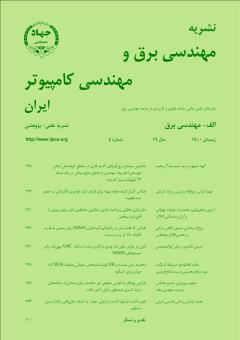طراحی کد فضا زمان در رادارهای آرایه فازی MIMO برای رسیدن به قدرت تفکیک بالا در برد و سرعت
محورهای موضوعی : مهندسی برق و کامپیوترروح اله وحدانی 1 , حسین خالقی 2 , محسن فلاح جوشقانی 3
1 - دانشگاه صنعتی مالک اشتر
2 - دانشگاه صنعتي مالك اشتر
3 - دانشگاه صنعتی مالک اشتر
کلید واژه: کد فضا زمان, رادار آرایه فازی MIMO, قدرت تفکیک, تابع ابهام, برنامهریزی غیر خطی,
چکیده مقاله :
در این مقاله، از کدهای فضا زمان برای رادار MIMO برای رسیدن به وضوح بالا در برد و سرعت هدف استفاده شده است. تابع ابهام دوبعدی به عنوان یک ابزار برای مقایسه عملکرد رادار در زمینه قدرت تفکیک شناخته میشود. یک کد فضا زمان میتواند بر اساس کمینهسازي فاصله بین پارامترهای واقعی هدف در برد، سرعت و زاویه طراحی شود. بدین منظور میتوان با تحلیل تابع ابهام و باریکسازی آن در حد امکان به قدرت تفکیک بالا دست یافت. در این مقاله، تابع ابهام با دو متغیر عدم انطباق دامنه و سرعت در نظر گرفته شده و یک معیار جدید برای دستیابی به عملکرد با وضوح بالا در این زمینه پیشنهاد گردیده است. در این مورد با استفاده از بهینهسازی توابع هزینه پیشنهادی، کد فضا زمان مطلوب استخراج میشود. طرح پیشنهادی را میتوان به رادار آرایه فازی MIMO نیز تعمیم داد. همچنین نتایج شبیهسازی نشان میدهد که طرح پیشنهادی ما دارای تابع ابهام بسیار باریک در اطراف مبدأ است در حالی که عملکرد بسیار نزدیک به حالت بهینه در زمینه احتمال شناسایی هدف را نیز دارا میباشد.
In this paper, space-time codes for MIMO radar are used to achieve high resolution at target range and speed. The two-dimensional ambiguity function is known as a tool to compare radar performance in terms of resolution. A space-time code can be designed based on minimizing the distance between the actual target parameters in range, speed and angle. For this purpose, high resolution can be achieved by analyzing the ambiguity function and narrowing it down as much as possible. In this paper, the ambiguity function with two variables of amplitude and speed mismatch is considered and a new criterion to achieve high resolution performance in this field is proposed. In this case, by optimizing the proposed cost functions, the optimal space-time code is extracted. The proposed design can also be extended to phased-MIMO radar. The simulation results also show that our proposed scheme has a very narrow ambiguity function around the origin, while it has a performance very close to the optimal state in terms of target identification probability.
[1] M. I. Skolnik, Introduction to Radar Systems, 3rd Ed. New York: Mc-Graw-Hill, 2001.
[2] J. Li and P. Stoica, MIMO Radar Signal Processing, Wiley-IEEE Press, 2008.
[3] N. Levanon and E. Mozeson, Radar Signals, Wiley-IEEE Press, 2004.
[4] E. Fishler, et al., "MIMO radar: an idea whose time has come," in Proc. IEEE Radar Conf., vol. 2, pp. 71-78, Philadelphia, PA, USA, 29-29 Apr. 2004.
[5] K. Luo, MIMO Radar: Target Localisation, Ph.D Thesis of Imperial College London, Mar. 2013.
[6] Z. Cheng, Z. He, B. Liao, and M. Fang, "MIMO radar waveform design with PAPR and similarity constraints," IEEE Trans. on Signal Processing, vol. 66, no. 4, pp. 968-981, Feb. 2018.
[7] W. Fan, J. Liang, and J. Li, "Constant modulus MIMO radar waveform design with minimum peak sidelobe transmit beampattern," IEEE Trans. on Signal Processing, vol. 66, no. 16, pp. 4207-4222, Aug. 2018.
[8] S. Imani, M. M. Nayebi, and S. A. Ghorashi, "Colocated MIMO radar SINR maximization under ISL and PSL constraints," IEEE Signal Processing Letters, vol. 25, no. 3, pp. 422-426, Mar. 2018.
[9] Y. Du, X. Zhao, S. Wang, H. Liu, and Z. Zhang, "MIMO radar waveform optimization in clutter under general power constraints," IEEE Access, vol. 8, pp. 106121-106135, Jun. 2020.
[10] J. Li and P. Stoica, "MIMO radar with colocated antennas," IEEE Signal Process. Mag., vol. 24, no. 5, pp. 106-114, Sept. 2007.
[11] A. Haimovich, R. Blum, and L. Cimini, "MIMO radar with widely separated antennas," IEEE Signal Process. Mag., vol. 25, no. 1, pp. 116-129, 2008.
[12] G. San Antonio, D. R. Fuhrmann, and F. C. Robey, "MIMO radar ambiguity functions," IEEE J. of Selected Topics in Signal Processing, vol. 1, no. 1, pp. 167-177, Jul. 2007.
[13] A. De Maio and M. Lops, "Design principles of mimo radar detectors," IEEE Trans. Aerospace and Electronic Systems, vol. 43, no. 3, pp. 886-898, Jul. 2007.
[14] C. Y. Chen and P. P. Vaidyanathan, "MIMO radar ambiguity properties using and optimization using frequency-hopping waveforms," IEEE Trans. Signal Processing, vol. 56, no. 12, pp. 5926-5936, Dec. 2008.
[15] K. Deb, Multi-Objective Optimization Using Evolutionary Algorithms, Springer, 2001.
[16] K. Miettinen, Nonlinear Multiobjective Optimization, Springer, 1998.
[17] R. Timothyand and J. S. Arora, "The weighted sum method for multi objective optimization: new insights," Structural and Multidisciplinary Optimization, vol. 41, no. 6, pp. 853-862, Dec. 2009.
[18] M. Mitchell, An Introduction to Genetic Algorithms, MIT Press, 1996.
[19] R. Larson and B. H. Edwards, Multivariable Calculus, Cenage Learning, 2014.
[20] W. Khan, I. M. Qureshi, and K. Soltan, "Ambiguity function of phased mimo radar with colocated antennas and its properties," IEEE Geoscience and Remote Sensing Letters, vol. 11, no. 7, pp. 1220-1224, Jul. 2014.
[21] L. de Haan and A. Ferreira, Extreme Value Theory: An Introduction, Springer, 2006.
[22] A. Hassanien and S. A. Vorobyov, "Phased-MIMO radar: a tradeoff between phased-array and mimo radars," IEEE Trans. Signal Processing, vol. 58, no. 6, pp. 3137-3151, Jun. 2010.
[23] M. Radmard, M. Nazari Majd, M. M. Chitgarha, S. M. Karbasi, and M. M. Nayebi, "MIMO ambiguity function optimization through waveform design," in Proc. 16th In. Radar Symp., IRS’15, pp. 333-338, , Dresden, Germany, 24-26 Jun. 2015.
[24] Y. Li, S. A. Vorobyov, and V. Koivunen, "Generalized ambiguity function for the mimo radar with correlated waveforms," in Proc. IEEE International Conf. on Acoustics, Speech and Signal Processing, ICASSP’14, pp. 5302-5306, Florence, Italy, 4-9 May 2014.


